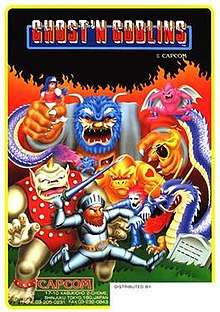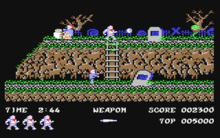Ghosts 'n Goblins (video game)
Ghosts 'n Goblins (Japanese: 魔界村, Hepburn: Makaimura, lit. Demon World Village) is a side-scrolling platform arcade game developed by Capcom and released in arcades in 1985. It is the first game in the Ghosts 'n Goblins franchise, and has since been ported to numerous home platforms, such as the Nintendo Entertainment System (NES) Commodore 64 (C64), Amiga and Atari ST. It was directed by Tokuro Fujiwara. It was also rereleased on the NES Classic Edition in 2016 and for iOS and Android in March 2017.
| Ghosts 'n Goblins | |
|---|---|
 Promotional arcade flyer | |
| Developer(s) | Capcom |
| Publisher(s) |
|
| Director(s) | Tokuro Fujiwara |
| Programmer(s) | Toshio Arima |
| Artist(s) | Masayoshi Kurokawa |
| Composer(s) | Ayako Mori |
| Series | Ghosts 'n Goblins |
| Platform(s) | Arcade, Amiga, Amstrad CPC, Android, Atari ST, Commodore 64 / 16, NES, Game Boy Color, IBM PC, iOS, MSX, ZX Spectrum |
| Release | Arcade September 19, 1985 NES Commodore 64
March 15, 2017 |
| Genre(s) | Platform |
| Mode(s) | Single-player, multiplayer |
| Cabinet | Upright |
| CPU | Motorola 6809 |
| Sound | 2x Yamaha YM2203 |
| Display | Horizontal |
The game received generally positive reviews and is often cited as one of the most difficult games of all time.
Gameplay
Ghosts 'n Goblins is a platform game where the player controls a knight, named Sir Arthur, who must defeat zombies, ogres, demons, cyclopes, dragons and other monsters in order to rescue Princess Prin-Prin, who has been kidnapped by Astaroth, king of Demon World. Along the way the player can pick up new weapons, bonuses and extra suits of armor that can help in this task.[1]
The player can only be hit twice before losing a life. Losing a life will result in having to restart the level, or starting at the halfway point if the player has managed to get that far. Furthermore, each life can only last a certain length of time. After defeating the final boss, the player must then replay the entire game on a higher difficulty level to reach the genuine final battle.[2]
Ports
Ghosts 'n Goblins was ported to Amiga, Amstrad CPC, Atari ST, Commodore 64, Commodore 16, NES, Game Boy Color, IBM PC compatibles, MSX, and ZX Spectrum.
Computers

The Commodore 64 version, released in 1986, contains music by Mark Cooksey, which borrows from Frédéric Chopin's Prelude No. 20. Due to the limited resources on the Commodore 64, it was somewhat different from the arcade version as it only features certain levels. The player also starts the game with fewer lives.
The version for Commodore 16/116 and Commodore Plus/4, also released in 1986 by Elite Systems, was even more limited than the C64 version. It was written to work on a Commodore 16, which had only 16 KB of RAM. Therefore, this version features only two levels and no music. In addition, the remaining two levels and the gameplay are simplified.
A version for the Amiga was released in 1990. While the hardware of the Amiga allowed an almost perfect conversion of the arcade game, it failed to emulate the success of the Commodore 64 version. The player starts the game with six lives, and no music plays unless the Amiga was equipped with at least 1 megabyte of RAM. The standard configuration of an Amiga 500 had 512 kilobytes.
Mark Cooksey composed the C64, Amiga and ST versions. David Whittaker composed the Amstrad CPC version.
Consoles
The Famicom version was released on June 13, 1986, and was the first Famicom game to utilize a 128 KB cartridge.[3] The North American NES version was released in November 1, 1986, and in Europe in 1989 (as Ghost 'n Goblins). The Famicom/NES version was programmed by Micronics and published by Capcom. It was composed by Harumi Fujita. Upon defeating the game a second time, the player is given the following message:
"Congraturation! This story is happy end. Thank you. Being the wise and courageour knight that you are you feel strongth welling. In your body. Return to starting point. Challenge Again!" [2]
The Famicom/NES ports served as the basis for the Game Boy Color version, which utilized passwords to allow the player to access certain levels. Allister Brimble composed this version.
Reception
| Reception | ||||||||||||||||||||||||||||
|---|---|---|---|---|---|---|---|---|---|---|---|---|---|---|---|---|---|---|---|---|---|---|---|---|---|---|---|---|
| ||||||||||||||||||||||||||||
| ||||||||||||||||||||||||||||
In Japan, Game Machine listed Ghosts 'n Goblins on their October 1, 1985 issue as being the second most-successful table arcade unit of the year.[16]
Computer Gaming World called Ghosts 'n Goblins "an excellent example of what the [NES] can do ... while hardly groundbreaking, [it] represents the kind of game that made Nintendo famous".[17]
Ghosts 'n Goblins was runner-up in the category of Arcade-Style Game of the Year at the Golden Joystick Awards.[18]
The NES version of Ghosts 'n Goblins was rated the 129th best game made on a Nintendo system in Nintendo Power's Top 200 Games list.[19] It was also a best seller for the NES, selling 1.64 million units.[20] The game is often cited as an example of one of the most difficult games of all time, due to its extremely hard level design and the fact that the enemies can spawn unexpectedly all over the map as well as that the player dies within two hits and must play through all the levels again at a higher difficulty setting unlocked after completing the levels regularly in order to beat the game, without any way to save. Gamerant named it the 5th hardest video game of all time.[21]
Legacy
Sequels
Ghosts 'n Goblins was followed by a series of sequels and spin-offs eventually becoming Capcom's 8th best-selling game franchise, selling over 4.4 million units.[22] Its sequels include Ghouls 'n Ghosts, Super Ghouls 'n Ghosts, and Ultimate Ghosts 'n Goblins in addition to producing the Gargoyle's Quest and Maximo spin-off series. Though originating as an arcade title, the franchise has been featured on a variety of PC and video game consoles with the latest entries in the series, Ghosts 'n Goblins: Gold Knights, released on the iOS. Additionally, the franchise frequently makes cameo appearances — the character of Arthur in particular — in other Capcom titles, the latest of which being Marvel vs. Capcom: Infinite (in which Firebrand, the Red Arremer that protagonizes the Gargoyle's Quest spin-off, also appears).
Re-releases
The NES version was also re-released for download for Nintendo's Virtual Console in North America on December 10, 2007 (Wii) and October 25, 2012 (Nintendo 3DS) and in the PAL region on October 31, 2008 (Wii) and January 3, 2013 (Nintendo 3DS) while the Wii U version was released in both regions on May 30, 2013. The arcade version was released on the Wii's Virtual Console Arcade in Japan on November 16, 2010, the PAL region on January 7, 2011 and in North America on January 10, 2011.
The original arcade version of the game was also included in the compilation Capcom Generations Vol.2: Chronicles of Arthur for the PlayStation (in Japan and Europe) and Sega Saturn (in Japan only), which also contained Ghouls 'n Ghosts and Super Ghouls 'n Ghosts. The three games (based on their Capcom Generation versions) were later collected as part of Capcom Classics Collection. The game was also featured in the compilation Capcom Arcade Cabinet for the PlayStation 3 and Xbox 360.
The Game Boy version was included in the Classic NES series for the Game Boy Advance, but only in Japan.
Nintendo re-released the NES version of Ghosts 'n Goblins as part of the company's NES Classic Edition.
The NES version of Ghosts 'n Goblins was re-released on Nintendo Switch Online upon launch, while an SP version titled Ghosts 'n Goblins: The Great Demon Lord Awaits was added to the service on December 13, 2018.
References
- "Ghosts 'n Goblins". The International Arcade Museum. Archived from the original on 27 March 2014. Retrieved 5 October 2013.
- Cinemassacre (2012-10-23), Ghosts N' Goblins - Angry Video Game Nerd - Episode 108, retrieved 2019-07-13
- "Famicom Disk System (Documentary)". The Gaming Historian (YouTube). Archived from the original on 2016-11-17. Retrieved 2016-07-14.
- "Ghosts 'n Goblins for NES". GameRankings. CBS Interactive. Archived from the original on 2018-09-25. Retrieved 2018-09-25.
- "Ghosts 'n Goblins for Game Boy Color". GameRankings. CBS Interactive. Archived from the original on 2018-09-25. Retrieved 2018-09-25.
- Cook, Brad. "Ghosts 'n Goblins - Review". Allgame. Archived from the original on November 15, 2014. Retrieved November 14, 2014.
- Miller, Skyler. "Ghosts 'n Goblins -Review". Allgame. Archived from the original on November 15, 2014. Retrieved November 15, 2014.
- "Archive - Magazine viewer". World of Spectrum. Retrieved 2012-10-24.
- "Archive - Magazine viewer". World of Spectrum. Retrieved 2012-10-24.
- "Archive - Magazine viewer". World of Spectrum. Retrieved 2012-10-24.
- "Ghosts 'n'Goblins". Ysrnry.co.uk. Archived from the original on 2013-03-14. Retrieved 2012-10-24.
- "Archive - Magazine viewer". World of Spectrum. Retrieved 2012-10-24.
- "Archive - Magazine viewer". World of Spectrum. Retrieved 2012-10-24.
- "Zzap!64 100th Issue Pull-Out Special Page 5". Zzap64.co.uk. Archived from the original on 2012-12-04. Retrieved 2012-10-24.
- Musgrave, Shaun (2017-03-17). "'Ghosts'n Goblins Mobile' Review – I'm Cold and I am Shamed, In my Boxers on the Floor". TouchArcade. Archived from the original on 2018-09-25. Retrieved 2018-09-25.
- "Game Machine's Best Hit Games 25 - テーブル型TVゲーム機 (Table Videos)". Game Machine (in Japanese). No. 269. Amusement Press, Inc. 1 October 1985. p. 31.
- Katz, Arnie; Kunkel, Bill; Worley, Joyce (August 1988). "Video Gaming World" (PDF). Computer Gaming World. No. 50. pp. 44–45, 47. Archived (PDF) from the original on 18 April 2016. Retrieved 23 April 2016.
- "Archive - Magazine viewer". World of Spectrum. Retrieved 2012-10-24.
- "NP Top 200". Nintendo Power. 200. February 2006. pp. 58–66.
- "CAPCOM | Platinum Titles". CAPCOM IR. Archived from the original on 2018-12-06. Retrieved 2017-07-13.
- "The 20 Hardest Video Games of All Time". Game Rant. 2017-04-09. Retrieved 2020-06-28.
- "Capcom release lifetime sales figures". Edge. 2010-10-12. Archived from the original on 2012-09-04. Retrieved 2010-07-14.
External links
- Ghosts 'n Goblins at the Killer List of Videogames
- Ghosts 'n Goblins at Arcade History
- Ghosts 'n Goblins at Lemon 64
- Ghosts 'n Goblins at Atari Mania
- Ghosts 'n Goblins at the Amiga Hall of Light
- Ghosts 'n Goblins (video game) at Curlie